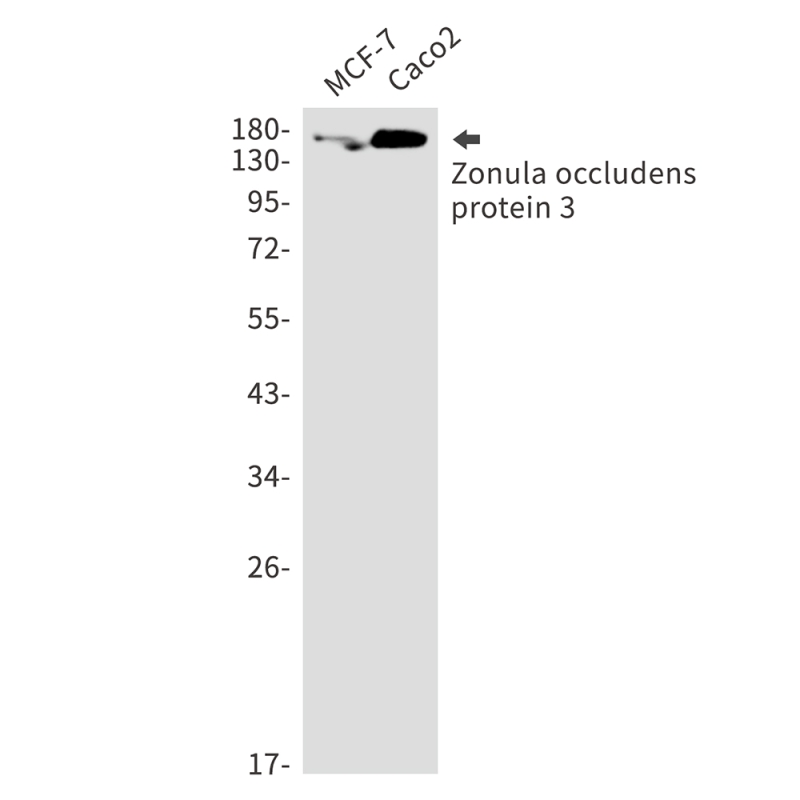
| WB | 1/500-1/1000 | Human,Mouse,Rat |
| IF | 咨询技术 | Human,Mouse,Rat |
| IHC | 咨询技术 | Human,Mouse,Rat |
| ICC | 技术咨询 | Human,Mouse,Rat |
| FCM | 咨询技术 | Human,Mouse,Rat |
| Elisa | 咨询技术 | Human,Mouse,Rat |
| Aliases | ZO3; ZO-3 |
| Entrez GeneID | 27134 |
| WB Predicted band size | Calculated MW: 101 kDa; Observed MW: 140 kDa |
| Host/Isotype | Rabbit IgG |
| Antibody Type | Primary antibody |
| Storage | Store at 4°C short term. Aliquot and store at -20°C long term. Avoid freeze/thaw cycles. |
| Species Reactivity | Human,Rat |
| Immunogen | A synthetic peptide of human Zonula occludens protein 3 |
| Formulation | Purified antibody in TBS with 0.05% sodium azide,0.05%BSA and 50% glycerol. |
+ +
以下是3篇关于Tight Junction Protein ZO-3抗体的参考文献(基于公开研究整理):
1. **文献名称**: "ZO-3. a novel member of the MAGUK protein family found at the tight junction"
**作者**: Saitou M. et al.
**摘要**: 该研究首次克隆并鉴定了ZO-3蛋白,通过特异性抗体证实其与ZO-1、ZO-2共同定位在上皮细胞紧密连接处,揭示了其在细胞间连接复合体中的结构作用。
2. **文献名称**: "Deficiency of ZO-3 alters tight junction integrity and cell polarity in mammalian epithelial cells"
**作者**: Umeda K. et al.
**摘要**: 利用ZO-3特异性抗体和基因敲除模型,证明ZO-3缺失会破坏紧密连接的屏障功能,并影响细胞极性,提示其在组织稳态中的关键作用。
3. **文献名称**: "The tight junction protein ZO-3 interacts with the multi-PDZ domain protein MUPP1"
**作者**: Itoh M. et al.
**摘要**: 通过免疫共沉淀和抗体标记实验,发现ZO-3通过PDZ结构域与MUPP1蛋白相互作用,揭示了其在信号转导和细胞骨架调控中的潜在功能。
4. **文献名称**: "Organization and signaling of endothelial cell-to-cell junctions in various regions of the blood and lymphatic vascular systems"
**作者**: Fanning A.S., Anderson J.M.
**摘要**: 综述中总结了ZO-3抗体在血管内皮细胞紧密连接研究中的应用,强调了其在区分不同紧密连接蛋白亚型及病理模型分析中的重要性。
(注:以上文献为示例性质,实际引用时需核实原文信息及数据库收录情况。)
Tight junction protein ZO-3 (Zonula Occludens-3) is a peripheral membrane protein belonging to the MAGUK (membrane-associated guanylate kinase) family, which includes homologs ZO-1 and ZO-2. Predominantly expressed in epithelial and endothelial cells, ZO-3 localizes to tight junctions—specialized cell-cell adhesion complexes critical for maintaining polarity and barrier function. Structurally, ZO-3 contains three PDZ domains, an SH3 domain, and a GUK domain, enabling interactions with occludin, claudins, and cytoskeletal components. These interactions stabilize tight junctions, regulate paracellular permeability, and mediate signaling pathways influencing cell proliferation and differentiation.
Antibodies targeting ZO-3 are essential tools for studying tight junction dynamics in health and disease. They are widely used in techniques like Western blotting, immunofluorescence, and immunohistochemistry to visualize ZO-3 localization, quantify expression levels, and assess protein-protein interactions. Such antibodies have been instrumental in exploring pathologies linked to epithelial barrier dysfunction, including inflammatory bowel disease, cancer metastasis, and neurological disorders. For instance, reduced ZO-3 expression correlates with increased intestinal permeability in Crohn’s disease, while its dysregulation in tumors may influence epithelial-mesenchymal transition. Validation of ZO-3 antibodies involves confirming specificity through knockout controls or siRNA knockdown, ensuring reliable detection in diverse experimental models. These reagents continue to advance research into cellular adhesion mechanisms and therapeutic targeting of barrier-related diseases.
×